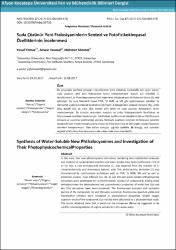Suda Çözünür Yeni Ftalosiyaninlerin Sentezi ve Fotofizikokimyasal Özelliklerinin İncelenmesi
Özet
Bu çalışmada periferal olmayan konumlarında tetra sübstitüe karboksilik asit uçları içeren,
suda çözünür, dört yeni ftalosiyanin türevi sentezlenmiştir. Bunun için öncelikle 3-
nitroftalonitril ile 4-merkaptobenzoikasit tepkimeye sokularak yeni bir ftalonitril türevi (1) elde
edilmiştir. Bu yeni ftalonitril türevi FTIR, 1
H NMR ve MS gibi spektroskopik teknikler ile
elementel analiz kullanılarak karakterize edilmiştir. 1 bileşiğinden çıkılarak metalsiz (2a), çinko
(2b), kobalt (2c) ve nikel (2d) metalli dört farklı ve suda çözünür ftalosiyanin türevi
sentezlenmiştir. Bu türevler arasındaki metalsiz ve çinko ftalosiyaninlerin fotofiziksel ve
fotokimyasal özellikleri incelenmiştir. Fotofiziksel özellik olarak bileşiklerin (2a ve 2b) floresans
emisyon ve uyarılma spektrumları alınmış, floresans kuantum verimleri ile floresans ömürleri
hesaplanmıştır. Fotokimyasal çalışma olarak ise bileşiklerin (2a ve 2b) singlet oksijen kuantum
verimleri hesaplanmıştır. Elde edilen sonuçlar ışığında özellikle 2b bileşiği, atık sulardaki
organik kirleticilerin foto bozunmasında kullanılmak üzere önerilebilir. In this work, four new phthalocyanine derivatives containing tetra-substituted carboxylic
acid moieties at nanperipheral position and water soluble have been synthesized. First of
all for this, a new phthalonitrile derivative (1) was obtained from the reaction of 3-
nitrophthalonitrile and 4-mercapto benzoic acid. This phthalonitrile derivative (1) was
characterized by spectroscopic techniques such as FTIR, 1
H NMR, MS and as well as
elemental analysis. Four different (2a, 2b, 2c and 2d) and water-soluble phthalocyanine
derivatives were synthesized by cyclotrimerization reaction of compound 1. Among these
phthalocyanines the photophysical and photochemical properties of metal-free (2a) and
zinc (2b) derivatives have been examined. The fluorescence emission and excitation
spectra of the compounds (2a and 2b) were examined, fluorescence quantum yields and
fluorescence lifetimes were calculated as photophysical properties. Singlet oxygen
quantum yields of the compounds (2a and 2b) were calculated as a photochemical study.
The results obtained show that in particular the compound 2bmay be suggested to be
used for photodegradation of organic pollutants in the waste water.
Kaynak
Fen ve Mühendislik Bilimleri DergisiCilt
17Sayı
2Bağlantı
http://fenbildergi.aku.edu.tr/wp-content/uploads/2017/10/021204469-478.pdfhttp://hdl.handle.net/11630/4635
Koleksiyonlar
- Cilt 17 : Sayı 2 [53]



















